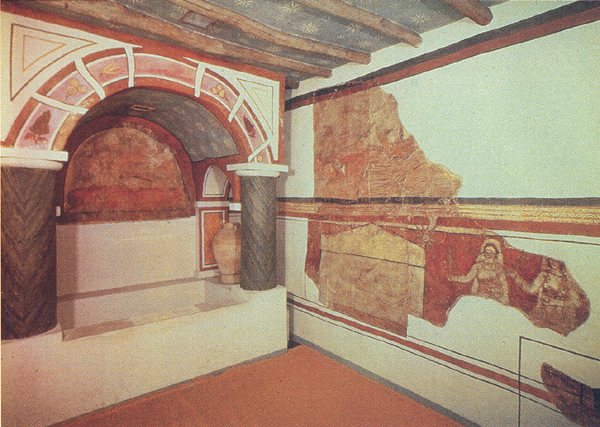Image Details

Yale University Art Gallery/Dura-Europos Collection
A painted procession of eight figures once marched across the walls of Dura’s third-century C.E. baptistery, shown after its removal from Syria and installation in the Yale University Art Gallery (Compare with reconstruction drawing of Dura third-century C.E. baptistery). Only the feet of five women remain on the eastern wall; the upper torsos of two figures and the elbow of a third have survived on the north wall.
At the head of the procession appears a large, white, gabled structure, identified by scholars as Jesus’ tomb. To its left, in an arched niche in the western wall, stands the baptismal font. The painting above the font, now badly deteriorated (compare with reconstruction drawing of baptismal font painting), depicts Jesus as “the good shepherd” who “lays down his life for the sheep” (John 10:11). Below Jesus, Adam and Eve grasp for fruit from the Tree of Knowledge.
Early Christians associated baptism with the resurrection of Jesus, as both promised salvation and deliverance from death, and they often celebrated the sacrament on Easter. The earliest Christians observed Easter in relation to the beginning of Passover, which could fall on any day of the week; later Christians moved to dissociate Easter from the Jewish calendar by observing it on a Sunday, the day, according to the Four Gospels, on which the resurrection occurred. Eventually, the weekly day of rest also moved to Sunday. Christians called Easter Sunday and the weekly holy day “the eighth day” because they commemorate Jesus’ resurrection on the eighth day after Palm Sunday, when he entered Jerusalem.
The procession of eight figures represents these eight days of Holy Week and reinforces the Christian belief in the eighth day as the proper day of worship. Behind the first three figures appear fragmentary traces of another architectural structure, which scholars have interpreted as the entrance to Jesus’ tomb. The first three figures, standing inside the tomb, thus represent the three days Jesus spent in the tomb before the resurrection.
